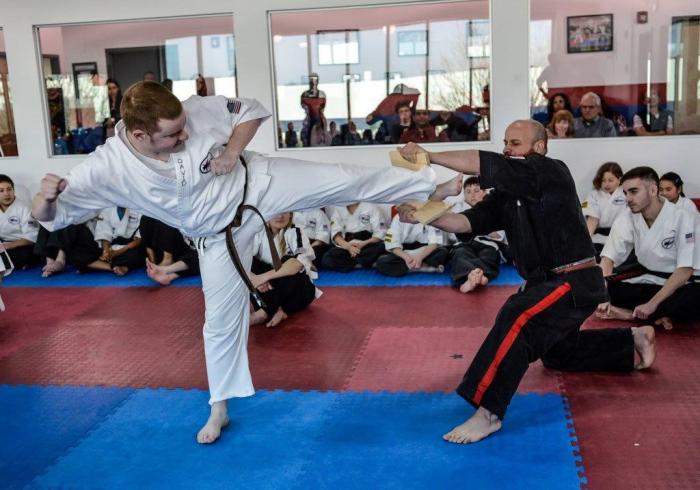Over/Under the Rainbow
By Barbara Crooker
Much has been written about including children with disabilities in the classroom, but I haven’t seen a lot of articles on integrating these children in sports. Back when our son Dave was first diagnosed (he has autism, or PDD/NOS), a writing friend and the father of a neurotypical child told me, “All boys need sports,” and I took that advice to heart. But what a long strange trip it’s been. Right off the bat, Special Olympics in our area said, “thanks, but no thanks” to “children like that with behavioral issues,” as did Dream Come True, Best Buddies, Cub Scouts… We tried Challenger League baseball, but found it to be exceedingly lame (everyone bats, every base runner scores, every game is tied 45-45). One of his Inclusion Aides was coaching a swim team, and she thought Dave would benefit from it, which he did, learning all the strokes, the racing dive, the flip turn, etc. This was great, until she moved from the area. Then the organization stopped sending us registration material (as a non-confrontational way to exclude him.) So we started looking at karate studios.
We found one with a Sensei (head coach) who was a terrific teacher, but who couldn’t get it together to pay the bills, so the studio moved to five or six different locations (including his ex-wife’s basement) until he finally gave up and folded the school. At this point, Dave had earned about six belts (they come in all the colors of the rainbow, plus white, brown, and black, and represent different levels of competency) and was making slow but continuous progress. So we looked for another school, and found ourselves at Leading Edge Martial Arts (LEMA) with Sensei Rob. Because they use slightly different techniques and testing levels, he had to go back to the White Belt level, but that didn’t bother him. Slowly but steadily, he worked his way back up the rainbow, passing all the various levels of testing, which is first done in class, then as a group during “graduation” ceremonies. To an outside observer, if you watched him in class, you wouldn’t detect any differences during warm-ups, which consists of calisthenics like jumping jacks, sit-ups, push-ups, stretches, etc. (He’s a beast!) It’s just in the katas (choreographed karate moves) where you see the awkward postures, his tentativeness. Grappling and sparring, too, are really difficult for him.
Here’s what was involved in the black belt criteria check list: recommendations from parents and employer, recommendations from two close friends (having a friend is a concept way beyond him, so we used recommendations from two friends of mine who take care of him when we’re away), a 500 word essay on “what a black belt means to me,” also delivered as a five minute speech (that took all of my teaching skills to draw this out of him), demonstration of all katas (forms) and self-defense moves, including strikes, blocks, kicks, stances; a four station board break, a written test, a professionally altered uniform, AND $250!
Here goes nothing, I figured. We did the essay, although I could only squeeze 150 words out of him. I had him create a word cluster of adjectives that applied to the black belts that he knows, and then I showed him how to use the thesaurus. I also broke the class down into its component parts, and had him qualify each of them. So, “grappling is hard, the warm-up exercises are easy, and board breaking is the most fun,” he told me. Except that he hasn’t gone to a board breaking class in years, and when he goes to a practice session, he seems to have forgotten what he has learned before, and it doesn’t go well. I was at home; he came in to see me and put on a sad face.
“That was hard. I was too tentative,” he said. I think, Gee, I wouldn’t believe my soft hand could break a hard board, either, although that contradicts what the Sensei told him: “You have to believe.” But he did break six boards…
A week before the test, the six candidates go for pre-testing. My husband comes home shaking his head—it’s going to be a four-hour test. We’re told about bringing high-protein snacks (of course, Dave’s have to be gluten and dairy-free) and water. Part of this will involve rounds of grappling and sparring, the two things he shrinks from. But Sensei says, “the most important thing is to not give up, to never quit.” And we think, Hmm, that’s the one thing he has going for him. He doesn’t give up.
The test really did take four hours. When we got there, the other parents were busy setting up their tripods and video recorders; we were busy praying and holding our breath. It started off with 50 pushups (!); he apparently lost count, but they counted for him and made him do ten more. Then they started in on arm motions and kicks (as a group), followed by the katas (structured moves). Suddenly, we realized he wasn’t wandering, picking his nose, or making faces in the mirror, but was actually concentrating. In fact, he was on fire; we’ve never seen him quite so focused. Yes, they gave him some breaks, especially in the grappling (wrestling) and sparring (punching/kicking) parts—he’s just not aggressive, doesn’t like to hurt people, so all he did was lamely throw soft punches and kicks, while the other parents were screaming at their kids to kill, kill, kill. Also, they let him use 8″ boards instead of 10″ ones for the four board breaks (hand, elbow, two foot strikes, one on each foot). This was perhaps the hardest area, as I mentioned above. Each candidate got three tries; one miss, and you had to retake the test. He had to go to the third try for each station, but he did it, and we have a very impressive photo taken by a professional photographer: Dave in mid-strike, perfect form with his foot through the broken board.
But here is the very best part: each candidate had to do a free-style routine (his was singularly non-impressive (simple moves), but he did it very well). One of the women (karate goes by skill sets, not age, so the class ranged from 12 to 42) lost her concentration and froze during her free-style. We heard a voice call out, “Val, you can do it.” And it was Dave.
So, he passed! He’s a Black Belt! And his parents are teary-eyed in wonder!
Was it worth it? It would have been so much easier to just give up. But then, it would have been so much easier not to pressure the school district to go to Full Inclusion, so much easier not to put him on a gluten and dairy-free diet, so much easier not to have embarked on behavior modification, etc. etc. I guess what Dave has taught us is to never give up, and we will never give up on him.
***
About the Author
 Barbara Crooker’s books of poetry are Radiance, winner of the Word Press First Book Award and finalist for the Paterson Poetry Prize; Line Dance, winner of the Paterson Award for Literary Excellence; More; Gold; Small Rain; and Barbara Crooker: Selected Poems. She was a finalist for the 2012 Pablo Neruda Poetry Prize, and her work appears in The Bedford Introduction to Literature. Barbara is the mother of a 31-year-old son with autism who lives with her at home. Learn more at www.barbaracrooker.com.
Barbara Crooker’s books of poetry are Radiance, winner of the Word Press First Book Award and finalist for the Paterson Poetry Prize; Line Dance, winner of the Paterson Award for Literary Excellence; More; Gold; Small Rain; and Barbara Crooker: Selected Poems. She was a finalist for the 2012 Pablo Neruda Poetry Prize, and her work appears in The Bedford Introduction to Literature. Barbara is the mother of a 31-year-old son with autism who lives with her at home. Learn more at www.barbaracrooker.com.

